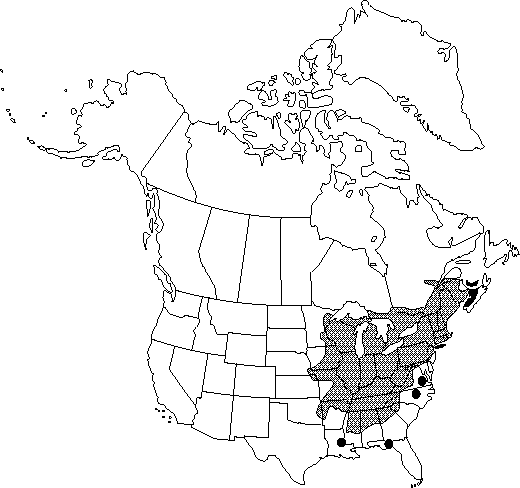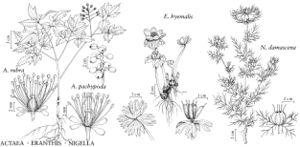Actaea pachypoda
Sketch. Bot. S. Carolina 2: 15. 1821.
Leaf blade: leaflets abaxially ± glabrous. Inflorescences at anthesis often longer than wide, short-cylindric. Flowers: petals truncate or cleft, often antherlike at apex; stigma sessile, 1.5-2.8 mm diam. during anthesis, as broad as or broader than ovary. Berries white, very rarely red, widely ellipsoid to nearly globose, 6.5-9 mm; pedicel bright red, stout, (0.7-)0.9-2.2(-3) mm diam., ± as thick as axis of raceme. Seeds 3.4-4.5 mm. 2n = 16.
Phenology: Flowering spring–early summer.
Habitat: Deciduous forests, less often with pines, junipers, or other conifers
Elevation: 0-1200 m
Distribution

N.B., N.S., Ont., P.E.I., Que., Ala., Ark., Conn., Del., Fla., Ga., Ill., Ind., Iowa, Kans., Ky., La., Maine, Md., Mass., Mich., Minn., Miss., Mo., Nebr., N.H., N.J., N.Y., N.C., Ohio, Okla., Pa., R.I., S.C., Tenn., Vt., Va., W.Va., Wis.
Discussion
The "eye" formed by the persistent stigma in Actaea pachypoda is larger than that in A. rubra.
Red- and pink-berried plants have been called Actaea pachypoda forma rubrocarpa (Killip) Fernald or A. ludovicii Boivin. Some of these plants are intermediate in morphology between A. pachypoda and A. rubra; they may be of hybrid origin. The sterility of fruits in many such plants lends support to this theory (R. S. Mitchell and J. K. Dean 1982).
Actaea pachypoda has been called A. alba (Linnaeus) Miller in some manuals (e.g., H. A. Gleason and A. Cronquist 1991; S. M. Walters et al. 1984+, vol. 3; Great Plains Flora Association 1986). Other authors (e.g., M. L. Fernald 1940; C. S. Keener 1977) have argued that the name A. alba is based on an illustration that is conspecific with the type of the European A. spicata Linnaeus and does not apply to plants here called A. pachypoda.
Native Americans prepared infusions from Actaea pachypoda to use medicinally as a gargle or throat aid (D. E. Moerman 1986).
